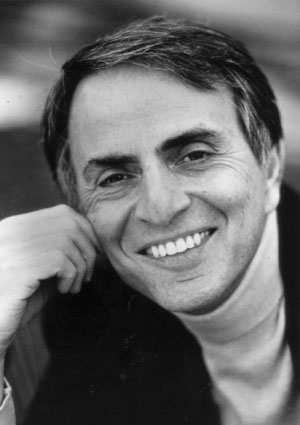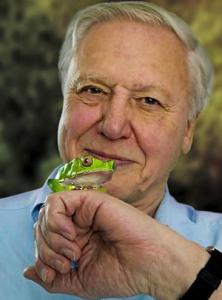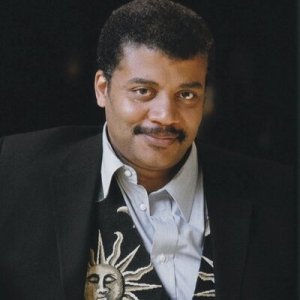Who was Carl Sagan and why is he important for Science, Science Communication and the public?
CARL SAGAN – THE SCIENTISTS
 The son of a Ukrainian Jewish immigrant, a curious boy, born in the poorer suburbs of New York in 1934, Carl Edward Sagan grew up to be one of the most influential astronomers of the 20th century. According to his own words, he got interested in science at the very early age of four, when his parents took him to the 1939 New York World’s Fair (1). Soon after he started frequenting the local library where he’d read about nature, cosmology, science fiction, where he tries to find or imagine the answers to his countless questions about the universe, the stars and everything related to them. He was a lucky child in terms of having his parent support his inquisitive character and providing him with science kits, books and science magazines for children. His teachers viewed him as a brilliant pupil, and few expressed opinions he ought to be in school for gifted children. Later, in high school, he recalls:
The son of a Ukrainian Jewish immigrant, a curious boy, born in the poorer suburbs of New York in 1934, Carl Edward Sagan grew up to be one of the most influential astronomers of the 20th century. According to his own words, he got interested in science at the very early age of four, when his parents took him to the 1939 New York World’s Fair (1). Soon after he started frequenting the local library where he’d read about nature, cosmology, science fiction, where he tries to find or imagine the answers to his countless questions about the universe, the stars and everything related to them. He was a lucky child in terms of having his parent support his inquisitive character and providing him with science kits, books and science magazines for children. His teachers viewed him as a brilliant pupil, and few expressed opinions he ought to be in school for gifted children. Later, in high school, he recalls:
“…A splendid day—when I began to suspect that if I tried hard I could do astronomy full-time, not just part-time.”(1)
He was one of the few college applicants to be considered for admission at all at the age of sixteen. Finally, he was accepted into the University of Chicago. A promising young scientist, he had worked on various projects, including some classified projects for the American government and NASA. Despite his numerous contributions to science as a lecturer, researcher and mentor of graduate students, he was denied a tenure position in Harvard University, where he was an assistant professor. He co-authored more than 500 scientific papers and finished his career at Cornell after spending almost 30 years as a tenured professor. He worked out that greenhouse gasses were the most probable cause of the extreme global warming observed on Venus, and subsequently warned the public that similar effects might very well be in the working of the climate change observed on Earth (2). He also studied Saturn and Jupiter’s atmosphere, a topic even more relevant in 2017 with the final stages of the Juno spacecraft and the reflection back to Sagan’s findings (3,4). He also drew a comparative evolution of the Martian and the Earth atmospheres based on the specific commonalities and differences between the two planets (5,6).
CARL SAGAN – THE CELEBRITY
Carl Sagan was a passionate advocate for science, rational thinking and the popularization of scientific principles. He believed that a big part of the scientific research is carried out with public funding, the public deserves to be informed regularly how their taxes are spent. Additionally, he was convinced that the widespread approval of increasing budgets for scientific research depends on this. To contribute to that himself, Sagan participated in public science debates. He authored, co-authored and was an editor of more than 20 science-related books. He was a frequent guest on television and radio shows. But what the wide public best knows him for is his TV series “COSMOS”. As many as 500 million viewers have seen the show about our universe’s origin and astonishing aspects in more than 60 countries after it was first aired in the 1920s (7). His nearly poetic descriptions of space and nature remained consistently accurate from a scientific standpoint and have admittedly charmed many children into STEM-related careers.
THE CARL SAGAN EFFECT
 Why was Sagan a controversial figure when today we appreciate his science and popularization efforts? Carl Sagan lived in a world where science was still a somewhat elitist environment, reserved for the privileged few who were willing to dedicate each waking hour to research. Academic institutes were still a relatively closed society where only the best and brightest were allowed in. Conformism to the customs and rules of the scientific community was the norm in the early 1960s. Hobbies, if any, were better to have been as different as possible from scientific research and writing. Sagan dedicating part of his time to communicate science to the lay audience and thus being in the spotlights was rumoured to be the unspoken thorn in the eyes of his peers. It is also why, per the general opinion, the panel of scientists reviewing his membership application for the National Academy of Sciences denied his admission.
Why was Sagan a controversial figure when today we appreciate his science and popularization efforts? Carl Sagan lived in a world where science was still a somewhat elitist environment, reserved for the privileged few who were willing to dedicate each waking hour to research. Academic institutes were still a relatively closed society where only the best and brightest were allowed in. Conformism to the customs and rules of the scientific community was the norm in the early 1960s. Hobbies, if any, were better to have been as different as possible from scientific research and writing. Sagan dedicating part of his time to communicate science to the lay audience and thus being in the spotlights was rumoured to be the unspoken thorn in the eyes of his peers. It is also why, per the general opinion, the panel of scientists reviewing his membership application for the National Academy of Sciences denied his admission.
The public loved Carl Sagan’s engagement and aspects of his communication became a pop culture phenomenon – ‘billions upon billions’ became somewhat of a catchphrase originating in the COSMOS series, and ‘sagan’ thus became a unit for measuring an immense number of anything. The academic circles at the same time stood divided. Some colleagues of his admired his ability to address science topics in accessible for wide audience ways. Others blamed him for being obsessed with his celebrity status and disapproved of allegedly sacrificing the quality of his scientific work for stardom. Not being recognised for his contribution to science, due to the misconception that an individual can only be either a scientist or a public figure, became known as ‘The Sagan Effect’. Today, we know that the value of his scientific works is equally high as the one of his prized peers who did not partake in science communication. Recent studies show that his work might have surpassed the merit of some of his contemporaries in many aspects. After the Second World War, with the development of mass media, the strive of the public for broader knowledge, and the looming demand for public approval of science budgets, the appearance of Carl Sagan and a few others before him as a scientist and a widely popular public figure, slowly built up the necessary critical mass for the birth of the Science Celebrity.
The rise of the celebrity scientists
Carl Sagan became a star figure thanks to his abilities to bring awe and wonder when talking of subjects generally considered as technical and uninteresting, but also due to the unmatched until then ease of access to information.
A NATURALIST, AN ASTROPHYSICIST AND A WOMAN WALK INTO A BAR…
DAVID ATTENBOROUGH
 A knighted naturalist and a broadcaster, Sir David Attenborough is probably the most popular naturalists to have ever appeared on television, and is a favourite of generations of curious viewers. He is best known for the series he co-authored and presented on BBC Natural History Unit – ‘Life’. He has formal education in natural sciences from the Clare College in Cambridge, UK, but quickly moved out of the research. After returning from Royal Army duty, he applied for and was accepted in a training course in BBC, becoming a producer of a factual broadcast program called ‘Talks’. Developing other programs and later being appointed in charge of programming for BBC Two allowed him to grow and further popularize science programs and campaigns for wild-life preservation. After ‘Life’, he had produced and recorded a number of natural or science-related programs, all achieving considerable success according to the TV ratings. Aside from being busy on-screen, Attenborough is heavily involved in radio programs, climate and wild-life preservation campaigns. By 2013 Sir Attenborough had 32 honorary degrees from British universities – more than any other individual (8) . He has written 25 books, received multiple awards, has been titled ‘the most trusted British celebrity’ in 2006 (9).
A knighted naturalist and a broadcaster, Sir David Attenborough is probably the most popular naturalists to have ever appeared on television, and is a favourite of generations of curious viewers. He is best known for the series he co-authored and presented on BBC Natural History Unit – ‘Life’. He has formal education in natural sciences from the Clare College in Cambridge, UK, but quickly moved out of the research. After returning from Royal Army duty, he applied for and was accepted in a training course in BBC, becoming a producer of a factual broadcast program called ‘Talks’. Developing other programs and later being appointed in charge of programming for BBC Two allowed him to grow and further popularize science programs and campaigns for wild-life preservation. After ‘Life’, he had produced and recorded a number of natural or science-related programs, all achieving considerable success according to the TV ratings. Aside from being busy on-screen, Attenborough is heavily involved in radio programs, climate and wild-life preservation campaigns. By 2013 Sir Attenborough had 32 honorary degrees from British universities – more than any other individual (8) . He has written 25 books, received multiple awards, has been titled ‘the most trusted British celebrity’ in 2006 (9).
NEIL DEGRASSE TYSON
A Harvard graduate, Neil deGrasse Tyson can be viewed as the 21st century iteration of Carl Sagan. An astrophysicist, an author and a radio/television presenter, Tyson admits himself to be heavily inspired by his predecessor.  Having written 14 books, numerous essays and opinion articles, alongside an equal number of highly-cited research publications, he (like Sagan) proves that communication does not necessarily deter a researcher from scientific pursuits. He has been a co-author and a host for several TV programs on PBS (including the reboot of ‘Cosmos: A Space-time Odyssey’), Star-Talk TV and radio, has been an adviser on several films, and appeared on several of the most popular American talk shows – much like any other non-scientist celebrity. Outside the lime-light he has mentored officially five theses, thought 20 widely popular college courses, and has earned twenty honorary doctorates from various institutes. He has received multiple awards, many of which – for his science communication, including the ‘Public Welfare Medal’ – the highest distinction given by the National Academy of Sciences for popularizing science (10). The same National Academy of Sciences that attempted to honor for the same achievement Sagan decades before after refusing his membership.
Having written 14 books, numerous essays and opinion articles, alongside an equal number of highly-cited research publications, he (like Sagan) proves that communication does not necessarily deter a researcher from scientific pursuits. He has been a co-author and a host for several TV programs on PBS (including the reboot of ‘Cosmos: A Space-time Odyssey’), Star-Talk TV and radio, has been an adviser on several films, and appeared on several of the most popular American talk shows – much like any other non-scientist celebrity. Outside the lime-light he has mentored officially five theses, thought 20 widely popular college courses, and has earned twenty honorary doctorates from various institutes. He has received multiple awards, many of which – for his science communication, including the ‘Public Welfare Medal’ – the highest distinction given by the National Academy of Sciences for popularizing science (10). The same National Academy of Sciences that attempted to honor for the same achievement Sagan decades before after refusing his membership.
SUSAN GREENFIELD
 Susan Adele Greenfield, or Baroness Greenfield, is a British neuroscientist working on Parkinson’s and Alzheimer’s as a research fellow in Lincoln College in Oxford University, UK. She is also a prominent writer, broadcaster, and member of the House of Lords. According to the latest available information, she has received as many honorary doctorates as Sir David Attenborough – 32, and many awards, including the ‘Michael Faraday Prize’ by the Royal Society of London for ‘excellence in communicating science to UK audiences’ and ‘The Most Excellent Order of the British Empire’ for her contribution to the public understanding of science. Nevertheless, some of her conclusions on the influence of modern entertainment on the brain are questioned by her peers, and the media is more frequently busy with what she’s wearing rather than her science. Why a scientist equally recognized as Sir Attenborough rises more talk about personal style rather than content, remains a flaw of our society (and this time, not only of the inherently patriarchal scientific circles). But the fact is that she too has achieved stardom by communicating science and debating on the importance of utilizing scientific principles in our everyday life.
Susan Adele Greenfield, or Baroness Greenfield, is a British neuroscientist working on Parkinson’s and Alzheimer’s as a research fellow in Lincoln College in Oxford University, UK. She is also a prominent writer, broadcaster, and member of the House of Lords. According to the latest available information, she has received as many honorary doctorates as Sir David Attenborough – 32, and many awards, including the ‘Michael Faraday Prize’ by the Royal Society of London for ‘excellence in communicating science to UK audiences’ and ‘The Most Excellent Order of the British Empire’ for her contribution to the public understanding of science. Nevertheless, some of her conclusions on the influence of modern entertainment on the brain are questioned by her peers, and the media is more frequently busy with what she’s wearing rather than her science. Why a scientist equally recognized as Sir Attenborough rises more talk about personal style rather than content, remains a flaw of our society (and this time, not only of the inherently patriarchal scientific circles). But the fact is that she too has achieved stardom by communicating science and debating on the importance of utilizing scientific principles in our everyday life.
Is Academia trying to overcome the Sagan Effect?
While Carl Sagan was not the first scientist to suffer heavy peer criticism for his hobby being related to science, he certainly became the poster child for this phenomenon and stirred the scientific community to reassess its views on the issue. With the rise of the scientific celebrities and the rediscovered curiosity for science in the wide public, has academia managed to keep up with the popular trends and has it overcome the Sagan Effect? Few developments in the academic status quo give hope that it may have:
REQUIREMENTS FOR GRANTS
In the past decades, the recognition from academic institutions and grant foundations for the need of science communication has significantly increased. In the European Union for example, in the scope of the 7th Research and Development Framework Programme (for short FP7), 330mln EUR have been budgeted for the theme ‘Science in Society’ (11). Additionally, the establishment of the ‘Science Communication Prize’ further supports the recognition of the increasing importance of communicating to the public. Specific calls in FP7 have been dedicated to the development of different media formats for communication of science – online tools, film and movie formats to target a wide population demographics (12). In parallel, organizations like The Swiss National Science Foundation, The Flemish Research Foundation (FWO), the Danish Lundbeckfonden, the Australian Queensland Government started providing grants specifically in support of popularizing science, or include a requirement to engage in science communication to the public in their grant criteria.
EDUCATING COMMUNICATORS
Naturally, far from every researcher has the talent to communicate or needs to engage in constant active science popularization. And while in the past science communication was left to the very few who ‘had it in them’, today less and less is left to chance and elusive talents. In the English-speaking world, more than anywhere else, training in various techniques and medias for science communication is widely spread, in the form of undergraduate courses, Master’s programs or Postgraduate degrees. An increasing number of scientists receive formal education on how to successfully communicate not only interesting and easily fascinating scientific discoveries, but also how to engage in controversial, topics related to ecology, nature preservation, energy and health (13). Many start pursuing this line of research after – what makes a particular manner of communicating science successful and in what context. And many more still shift focus completely to dedicate their entire careers to science communication and popularization.
FREEDOM TO COMMUNICATE
By financially and curricularly supporting science communication, it appears that academic institutions have finally embraced the powerful tool it was proven to be. As all current efforts to promote science communication as an intrinsic part of scientific research are a significant step in the right direction, it remains questionable how well exactly it works in practice. The workload of today’s researchers has increased steadily – with the shortage of funds and growing competition, scientists often struggle to balance the pursuit for grants with the very research they are trying to fund. Less and less time is left for anything else, including communication to audiences other than peers and funding agencies. Has then Academia really outgrown the Sagan Effect or has it somehow found a way to naturally select based on it (14)? Why many researchers decide to choose science communication as a career alternative to scientific research, instead of practically combining them? Are scientific celebrities of the rank of Neil deGrasse Tyson, Sir David Attenborough, Steven Hawking, Richard Dawkins, Jane Goodall or Susan Greenfield seemingly effortlessly combining the pursuit for knowledge and the burdens of fame as an exception to a rule that the two are generally incompatible? Is the pursuit of stardom the right way to go in order to popularize science or is it purely a satisfaction of ones’ own ego (15)? Given that many scientists followed suit without giving up on research, it is a comforting thought to think that Academia is indeed putting extra care into overcoming the Sagan Effect and that, as everything good, just takes time to succeed.
SOURCE MATERIALS
1. Davidson, K. & Sagan, C. Carl Sagan : a life. (J. Wiley, 1999).
2. Sagan, C. Cosmos. (Random House, 1980).
3. Smith, B. A. et al. The Jupiter System Through the Eyes of Voyager 1. Science 204, (1979).
4. Smith, B. A. et al. Encounter with Saturn: Voyager 1 Imaging Science Results. Science 212, (1981).
5. Sagan, C. & Mullen, G. Earth and Mars: Evolution of Atmospheres and Surface Temperatures. Science 177, 52–56 (1972).
6. Mutch, T. A. et al. The Surface of Mars: There View from the Viking 1 Lander. Science 193, (1976).
7. Carl Sagan – Minnesota State University. Available at: https://goo.gl/PEVSmF.
8. Eichner Herrmann, Joshi; Rivlin, Jack; Howie, M. Sir David Attenborough heads lists of most honoured by Britain’s universities – Telegraph. (2010). Available at: https://goo.gl/4ZRrc9.
9. Hoggart, S. Simon Hoggart’s week: In David we trust … but not Peter | Politics | The Guardian. (2006). Available at: https://goo.gl/NBdywR.
10. Galvin, M. & USA, N. A. of S. Neil deGrasse Tyson to Receive Public Welfare Medal. (2015). Available at: https://goo.gl/sWCY2v.
11. Changes to the Capacities Work Programme: Science in Society Theme. (2007).
12. Patkós, E. A Short Guide to EU Grants for Science Communication. Available at: https://goo.gl/Cs2gaR.
13. Brownell, S. E., Price, J. V & Steinman, L. Science Communication to the General Public: Why We Need to Teach Undergraduate and Graduate Students this Skill as Part of Their Formal Scientific Training. J. Undergrad. Neurosci. Educ. 12, E6–E10 (2013).
14. Martinez-Conde, S. Has Contemporary Academia Outgrown the Carl Sagan Effect? J. Neurosci. 36, 2077–2082 (2016).
15. Hall, N. The Kardashian index: a measure of discrepant social media profile for scientists. Genome Biol. 15, 424 (2014).

